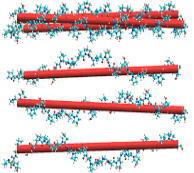Edible Film-forming potential of Gelatin Blends With Glycerol and Sorbitol for Application in Instant Noodle Seasoning Powder Packaging
Main Article Content
Abstract
This study aimed to investigate the potential of edible films made from gelatin combined with glycerol and sorbitol, and to apply these films to the packaging of instant noodle seasoning powder. Films were formed by dissolving gelatin at concentrations ranging from 4% to 8% (w/v) in a plasticizer mixture composed of glycerol and sorbitol at 25% (w/w). The dissolution was carried out at 55 °C for 30 minutes. Mechanical strength, weld strength, and film solubility were measured to evaluate the quality of the films. The study found that the best film formation was achieved by combining 8% gelatin with a 25% (w/w) glycerol-sorbitol mixture in an 80:20 ratio. The resulting film exhibited excellent tensile strength of 156.28 MPa, weld strength of 27.11 MPa, and hot water solubility of 96.57%. The film was then applied to the packaging of instant noodle seasoning powder, which demonstrated good preservation of the noodles' structure and quality after 50 days of storage. This study provides an overview of the potential of combining various materials to create edible films for sustainable and environmentally friendly packaging.
Downloads
Article Details

This work is licensed under a Creative Commons Attribution-NonCommercial-NoDerivatives 4.0 International License.
How to Cite
References
Saki TA, Sweah ZJ, Bahili MA. Effect of maleated polyethylene wax on mechanical and rheological properties of LDPE/starch blends. Trop J Nat Prod Res. 2021; 5(6):1060–1065. doi:10.26538/tjnpr/v5i6.13
Barlow CY, Morgan DC. Polymer film packaging for food: An environmental assessment. Resour Conserv Recycl. 2013; 78:74–80. doi: 10.1016/j.resconrec.2013.07.003
Ncube LK, Ude AU, Ogunmuyiwa EN, Zulkifli R, Beas IN. An overview of plastic waste generation and management in food packaging industries. Recycling. 2021; 6(1):1–25. doi:10.3390/recycling6010012
Bala A, Arfelis S, Oliver-Ortega H, Méndez JA. Life cycle assessment of PE and PP multi film compared with PLA and PLA reinforced with nanoclays film. J Clean Prod. 2022; 380:134891. doi:10.1016/j.jclepro.2022.134891
Santhosh R, Nath D, Sarkar P. Novel food packaging materials including plant-based byproducts: A review. Trends Food Sci Technol. 2021; 118:471–489. doi: 10.1016/j.tifs.2021.10.013
Dhumal CV, Ahmed J, Bandara N, Sarkar P. Improvement of antimicrobial activity of sago starch/guar gum bi-phasic edible films by incorporating carvacrol and citral. Food Packag Shelf Life. 2019; 21:100380. doi:10.1016/j.fpsl.2019.100380
Francisco CB, Pellá MG, Silva OA, Raimundo KF, Caetano J, Linde GA, Colauto NB, Dragunski DC. Shelf-life of guavas coated with biodegradable starch and cellulose-based films. Int J Biol Macromol. 2020; 152:272–279. doi:10.1016/j.ijbiomac.2020.02.249
Dhumal CV, Pal K, Sarkar P. Synthesis, characterization, and antimicrobial efficacy of composite films from guar gum/sago starch/whey protein isolate loaded with carvacrol, citral and carvacrol-citral mixture. J Mater Sci Mater Med. 2019; 30(10):1–14. doi:10.1007/s10856-019-6317-8
Vásconez MB, Flores SK, Campos CA, Alvarado J, Gerschenson LN. Antimicrobial activity and physical properties of chitosan–tapioca starch based edible films and coatings. Food Res Int. 2009; 42(7):762–769. doi:10.1016/j.foodres.2009.02.026
Mahcene Z, Khelil A, Hasni S, Akman PK, Bozkurt F, Birech K, Goudjil MB, Tornuk F. Development and characterization of sodium alginate based active edible films incorporated with essential oils of some medicinal plants. Int J Biol Macromol. 2020; 145:124–132. doi:10.1016/j.ijbiomac.2019.12.093
Scartazzini L, Tosati JV, Cortez DHC, Rossi MJ, Flôres SH, Hubinger MD, Luccio MD, Monteiro AR. Gelatin edible coatings with mint essential oil (Mentha arvensis): film characterization and antifungal properties. J Food Sci Technol. 2019; 56(9):4045–4056. doi:10.1007/s13197-019-03873-9
Paglione IS, Galindo MV, de Medeiros JAS, Yamashita F, Alvim ID, Grosso CRF, Sakanaka LS, Shirai MA. Comparative study of the properties of soy protein concentrate films containing free and encapsulated oregano essential oil. Food Packag Shelf Life. 2019; 22:100419. doi:10.1016/j.fpsl.2019.100419
Fazilah A, Maizura M, Karim A, Bhupinder K, Bhat R, Uthumporn U, Chew SH. Physical and mechanical properties of sago starch - Alginate films incorporated with calcium chloride. Int Food Res J. 2011; 18(3):1027–1033.
Prodpran T, Benjakul S, Artharn A. Properties and microstructure of protein-based film from round scad (Decapterus maruadsi) muscle as affected by palm oil and chitosan incorporation. Int J Biol Macromol. 2007; 41(5):605–614. doi:10.1016/j.ijbiomac.2007.07.020
Debeaufort F, Martin-Polo M, Voilley A. Polarity homogeneity and structure affect water vapor permeability of model edible films. J Food Sci. 1993; 58(2):426–429. doi:10.1111/j.1365-2621.1993.tb04290.x
Chalykh A, Pavel Z, Tatiana C, Rubtsov A, Svetlana Z. Water vapor permeability through porous polymeric films with various hydrophilicity as synthetic and natural barriers. Polymers. 2020; 12(2):282. doi:10.3390/polym12020282
García M, Martino MN, Zaritzky N. Lipid addition to improve barrier properties of edible starch‐based films and coatings. J Food Sci. 2000; 65:941–944. doi: 10.1111/j.1365-2621.2000.tb09397.x
Nur Hanani A, Beatty E, Roos Y, Morris M, Kerry J. Development and characterization of biodegradable composite films based on gelatin derived from beef, pork and fish sources. Foods. 2013; 2(1):1–17. doi:10.3390/foods2010001
Thomazine M, Carvalho RA, Sobral PJA. Physical properties of gelatin films plasticized by blends of glycerol and sorbitol. J Food Sci. 2005; 70(3):172–176. doi:10.1111/j.1365-2621.2005.tb07132.x
Bergo P, Sobral P, Prison JM. Effect of glycerol on physical properties of cassava starch films. J Food Process Preserv. 2010; 34:401–410. doi: 10.1111/j.1745-4549.2008.00282.x
Kozłowska J, Skopińska-Wiśniewska J, Kaczmarek-Szczepańska B, Grabska-Zielińska S, Makurat-Kasprolewicz B, Michno A, Ronowska A, Wekwejt M. Gelatin and gelatin/starch-based films modified with sorbitol for wound healing. J Mech Behav Biomed Mater. 2023; 148:106205. doi:10.1016/j.jmbbm.2023.106205
Engler LG, Farias NC, Crespo JS, Gately NM, Major I, Pezzoli R, Devine DM. Designing sustainable polymer blends: tailoring mechanical properties and degradation behaviour in PHB/PLA/PCL blends in a seawater environment. Polymers. 2023; 15(13):2874. doi:10.3390/polym15132874
Ozdemir M, Floros JD. Optimization of edible whey protein films containing preservatives for water vapor permeability, water solubility and sensory characteristics. J Food Eng. 2008; 86(2):215–224. doi:10.1016/j.jfoodeng.2007.09.028
Wang W, Sain M, Cooper PA. Study of moisture absorption in natural fiber plastic composites. Compos Sci Technol. 2006; 66(3–4):379–386. doi:10.1016/j.compscitech.2005.07.027


